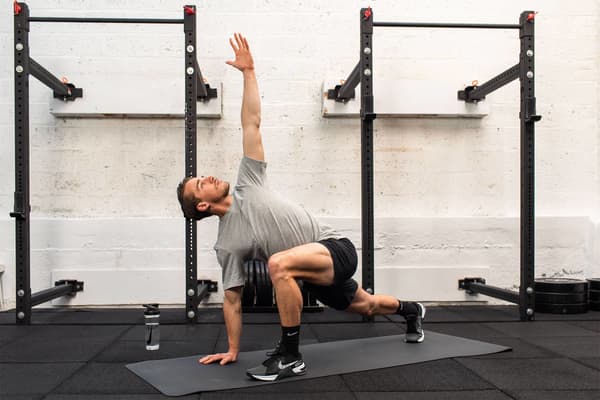How Much Exercise Is Too Much? Experts Explain the Risks
Sport & Activity
Health professionals explain how overtraining can cause sleep disruption, injury and even amenorrhea.

An exercise routine has the power to improve your overall well-being. But, as is the case with so many other things in life, quantity is important—and it's possible to exercise too much. It's true: exercising excessively can interfere with your ability to reap the benefits you're working to achieve, and can set you up for injury, insomnia and, in some extreme cases, amenorrhea.
Below, experts explain what qualifies as too much exercise, as well as seven common signs that you might be overdoing it.
(Related: Should You Work Out When You're Sore?)
How much exercise is too much?
What qualifies as the right amount of exercise varies from person to person. Broadly speaking, the ideal exercise routine meets the US Department of Health and Human Services recommendation of at least 150 minutes of moderate aerobic activity per week. Of course, your workout programme should always be created with your specific health and fitness goals in mind.
As Jake Harcoff, MS, CSCS and CISSN explained, the correct amount of exercise for someone who wants to stay in shape is going to be different to the correct amount of exercise for someone who wants to win a race.
"Either way, what's most important is that the programme allows ample time for your body to recover and repair between sessions", Harcoff said.
If you don't give your body enough time to recover before your next session, you run the risk of developing overtraining syndrome, a condition marked by too much exercise and too little recovery. The US Department of Health and Human Services does not specify an upper limit of exercise at which this condition becomes a risk.
As a general rule, women's health specialist Felice Gersh, MD, said 90 minutes per day is the point when people become susceptible to overtraining syndrome and its associated symptoms.
But some individuals may not even need to exercise that much to experience symptoms of overtraining, according to licensed physiotherapist Grayson Wickham, DPT and CSCS. Ultimately, it's a question of whether or not the exercise you're doing is appropriate for you and your given fitness level, he said.
7 Signs and Symptoms of Exercising Too Much
1.Your Athletic Performance Is Plummeting
If you're consistently falling short of your usual race pace or having to remove weight plates from the squat bar, this is your body telling you it needs a rest day—or several.
When you exercise, you are causing tiny microscopic tears in the muscle fibres, Harcoff said. After your workout, your body gets to work on repairing those tears. Once repaired, these muscle fibres are even stronger and more resilient than they were before.
This process, however, takes about 24 to 48 hours. So, if you start working those same muscle fibres before they've fully repaired from your last workout, you won't reap the rewards of your labour. If you keep breaking the same muscle fibres down over and over and never allow them to repair, you're causing them to whittle away, Wickham said. The result? You get weaker. Or worse, you get injured (more on this below).
Your move: keep a fitness journal where you log all of your reps, sets, weights and mileage, as well as how difficult your workouts feel. This kind of tracking will help you keep an eye on your overall volume.
2.You've Got a Nagging Injury (or Two)
To reiterate: if you exercise too much, your body is unable to repair itself between sessions. "If your body cannot recover, you could begin to experience chronic pain in your joints and muscles", Harcoff said. "In extreme cases, you can even get injured".
If you have an injury, in addition to seeing a physiotherapist or orthopaedic specialist, you'd also benefit from asking a personal trainer to look at your movement patterns. Sometimes these kinds of injuries are exacerbated by imperfect movement patterns.
(Related: How to Increase Your Running Mileage Without Getting Injured, According to Experts)
3.You're Moody
You may be quick to blame your grumpiness on your recent interaction with your colleague or loved one. But if your mood has been sour for a few weeks, your sweat schedule could be the culprit.
"Becoming more irritable, depressed or starting to lack the motivation to exercise are all indicators of overtraining", Harcoff said.
Sports medicine specialists have created something called the Brief Assessment of Mood (BAM+), which is a test designed to help coaches keep an eye on athletes' mental well-being. This test helps monitor their players for signs of depression and also helps gauge how their bodies are responding to training load, Harcoff said.
Indeed, one 2017 study published in the Journal of Science and Sports Medicine found that an athlete's BAM+ score, which uses psychological symptoms to determine whether or not an athlete is overtraining, could be used to predict physiological symptoms of overtraining. High creatine kinase levels in the bloodstream are just one indicator, for example.
4.Your Sleep Has Been Off
While you might think that logging hours in the weight room or miles on the trail would help you sleep deeply, going overboard on exercise can actually interfere with your sleep quality and quantity.
When you overtrain, your cortisol (that's the main stress hormone) levels go up. While you need some cortisol to live, chronically high cortisol levels can disrupt your sleep schedule, Wickham said.
"Some people start to become insomniacs and stop being able to fall asleep when they want, and other people can fall asleep but can't stay asleep".
It's common for people experiencing these symptoms to report feeling tired (while also wired) and to develop an increased reliance on caffeine, according to Wickham. But that's not even the worst of it. He explained: Your body produces the greatest amount of human growth hormone, the main hormone involved in muscle recovery, in your sleep.
"When you stop being able to sleep, you can enter a negative feedback cycle where you're recovering less and less and less", he said.
(Related: The Benefits of Drinking Coffee Before or After Working Out, According to Experts)
Implementing sleep hygiene tactics like going to bed at the same time every night and leaving your electronics away from your bed may help. But if overtraining is truly the root of your subpar sleep, the only thing that's going to help is exercising less, recovering more and fuelling properly.
5.Your Resting Heart Rate Is Elevated
If you sport a wearable device, consider looking at more than just how many steps you're logging each day—changes in your resting heart rate will help you figure out if you're training a sustainable amount for your body.
"When you're overtraining, your resting heart rate goes up", said Reda Elmardi, RD and CSCS. "Your heart rate beating faster than normal is a sign that your body is working harder than usual", he said.
Research has demonstrated that if you've been training at higher intensities or volumes than normal, your body (including your heart!) is going to go into overdrive, trying to help your body recover from said exercise.
6.The Menstrual Cycle is MIA
Most people think there are just four vital signs, but there are actually five. "Your menstrual cycle is known as the fifth vital sign, which means it is used as one of the measures of overall well-being", Gersh said.
So, when athletes lose their period, it's a symptom that there is an underlying issue with their body. Known medically as amenorrhea, the loss of a period suggests that a person is not healthy enough to sustain a pregnancy.
"The reproductive system literally starts to shut down, which results in a person producing less oestrogen", she said.
Far more than just a pregnancy hormone, oestrogen is responsible for helping to maintain strong bones. If oestrogen levels dip, the risk for bone breaks as well as osteoporosis goes up. Not ideal considering that bones need to be fully intact to compete, regardless of the sport.
"Typically, someone loses their period because they are both over-exercising and under-eating", Gersh said. Although it's worth noting that amenorrhea can also be caused by some types of intrauterine device, contraceptive and other medication.
The typical treatment plan for exercise-induced amenorrhea involves scaling back on training for a week and working with a nutritionist or registered dietitian to ensure you're consuming the fuel you need. Sometimes healthcare providers will prescribe an oestrogen supplement to give the body the oestrogen it's not currently making naturally, according to Gersh.
7.Your Menstrual Cycle Has Changed
Generally, a skipped period is more noticeable than a period that is lighter or comes a few days late. Gersh suggested paying attention to the frequency and volume of flow too, especially if big races or intense workouts are on the schedule.
It's uncommon for individuals to go from having a normal period one month to no period the next, she added.
"Typically, people have intermediary signs that they're at risk for amenorrhea, losing their period", she said. These signs include: irregular cycles, reduced amount of menstrual bleeding and spotting.
If there are changes in a cycle, she suggested talking to a healthcare provider who can determine proper fuelling and recovery plans to reduce risk of period loss, which can jeopardise an athlete's overall health.
Words by Gabrielle Kassel





